Comments / Questions (197)
![]() Lone Sørensen wrote:
Lone Sørensen wrote:
Jeg strikker i str. M. I afsnittet ryg og forstykke står der, at man skal tage 2 m ind på hver side af mærketrådene efter 4 cm, samt derefter efter 9 cm 2 gange, men efter 18 cm skal der tages 1 m ud på hver side af mærketrådene? På det tidspunkt vil arb. måle 22 cm. Skal der ikke stå på hver 9 pind 2 gange? istedet for cm.
18.07.2020 - 11:24DROPS Design answered:
Hej Lone, du tager 2 masker ind i hver side når arb måler 4 cm og 13 cm = 140m. Når arb måler 18 cm tager du 2 masker ud i hver side for hver 4.cm ialt 4 gange = 156 masker. God fornøjelse!
31.07.2020 - 08:11
![]() Valérie wrote:
Valérie wrote:
Bonjour, De quelle manière sont montées les mailles pour avoir une jolie bordure comme sur la photo (mailles inclinées de l'autre côté par rapport au modèle Cornflower Top) ? "Continuer en rond ainsi jusqu'à ce que les côtes mesurent 3 cm." : sur la photo il y a 6 rangs de côtes mais 6 rangs de côtes ne font pas 3 cm. Les photos sont-elles censées représenter ce qu'on doit obtenir ? Merci de vos réponses.
04.07.2020 - 14:14DROPS Design answered:
Bonjour Valérie, les mailles sont montées à la méthode continentale - en fonction de votre tension en hauteur, il vous faudra peut être un nombre de rangs différent pour les 3 cm de côtes, ce qui compte c'est ici la hauteur, continuez jusqu'à ce que vous ayez ces 3 cm. Bon tricot!
06.07.2020 - 08:30
![]() Pernille Raun wrote:
Pernille Raun wrote:
Hej. Jeg forstår ikke udregningen vedr. udtag til raglan. Jeg strikker L. Hvis jeg skal øge med 2 masker på hver side af mærketrådene, så øges der da med 16 masker pr. omgang og ikke 8. Tilsvarende når man øger med 1 på hver side af mærketråden, så bliver antallet på en omgang 8. Dette betyder, at jeg, når bærestykket er færdigt, sidder tilbage med 338 masker og ikke 250 masker - hvor er det jeg går galt?
11.06.2020 - 15:45DROPS Design answered:
Hej Pernille, du øger kun til raglan på forstykket og på bagstykket (ikke på ærmerne). Først øger du 2 masker i hver side = 4 masker på forstykket og 4 masker på bagstykket. God fornøjelse!
12.06.2020 - 10:54
![]() Mª José wrote:
Mª José wrote:
Hola me llamo Mª José y tengo el canal El punto Inglés donde tengo un Jersey publicado el 25.08.2016 que guarda mucha similitud con este. Me ha sorprendido enormemente!! ya que en mi Instagram punto_ingles me están haciendo preguntas para resolver algunos problemas que están teniendo con las instrucciones que dan de su jersey con los aumentos del ranglan y que casualmente coinciden con los comentarios que les hacen a ustedes en Comentarios/ Preguntas. Saludos.
10.06.2020 - 23:37
![]() Elena wrote:
Elena wrote:
Hola, En el ranglan, ¿en qué vuelta tengo que aumentar 8 puntos, y en qué vuelta tengo que aumentar 4 puntos?? Gracias
10.06.2020 - 17:26DROPS Design answered:
Hola Elena. Primero aumentas 8 puntos en cada 2ª vuelta una vuelta aumentas, en la siguiente no, en la siguiente sí...) el nº de veces según la talla que trabajas, después de completar esta parte aumentas 4 puntos en la vuelta cada 2ª vuelta (una aumentas, la siguiente no, la siguiente sí...) también el nº de veces según la talla.
13.06.2020 - 20:36
![]() Wilma Vrijs wrote:
Wilma Vrijs wrote:
In het patroon staat na het afronden van de pas: Brei dan in de buitenste steek aan elke kant van het voorpand en het achterpand in op de mouwen. Dat begrijp ik niet, sorry. Wat betekent dat?
10.06.2020 - 07:57DROPS Design answered:
Dag Wilma,
Het staat er inderdaad een beetje vreemd, maar de buitenste steken van de panden worden nu bij de mouwen gezet. Maar hier hoef je verder niks te doen, het staat er alleen als extra informatie. Je kunt het patroon voortzetten vanaf de volgende zin: 'Brei de volgende naald als volt...' , dan wijst het zich vanzelf.
10.06.2020 - 11:43
![]() Lata wrote:
Lata wrote:
Buonasera, non capisco gli aumenti del raglan perché se aumento 2 maglie prima del segno e 2 dopo il segno essendo quattro i segni che dividono il davanti e il dietro dalle maniche gli aumenti diventando 16 per giro, cosa sbagliato? Grazie
09.06.2020 - 23:40DROPS Design answered:
Buongiorno Lata. Deve aumentare solo sul davanti e sul dietro, non sulle maniche. Quindi aumenta 2 maglie 4 volte sul giro, in tutto 8 maglie. Buon lavoro!
10.06.2020 - 12:01
![]() Lara wrote:
Lara wrote:
Buongiorno, il mio campione non risulta uguale al vostro ho infatti 22 maglie in larghezza anzichè 17 come il vostro. Non posso usare un ago più grande perchè la trama risulta troppo larga, come posso regolarmi per l'avvio delle maglie? Forse 112 per la taglia S sono troppe poche? Grazie molte!
08.06.2020 - 11:46DROPS Design answered:
Buongiorno Lara, questo modello e in generale questo filato richiede una tensione di 17 maglie in larghezza, indipendentemente dalla trama. Buon lavoro!
12.06.2020 - 10:13
![]() STURM wrote:
STURM wrote:
Un grand merci !! je viens de comprendre mon erreur !
03.06.2020 - 17:07
![]() STURM wrote:
STURM wrote:
Y a-t-il une erreur dans les explications au niveau de l\'empiècement ? je suis après la bordure avec les aig. 5. Dans les explications, je devrais poursuivre partout en côte (soit env, soit end, comme les mailles se présentent). Sur la photo, après la bordure en aig 3,5, le devant et le dos sont en jersey end. alors que les explications poursuivent pendant 15 cm en côtes end/ env partout. Les explications ne font commencer le jersey endroit qu'après l'augmentation pour les manches.
02.06.2020 - 21:37DROPS Design answered:
Bonjour Mme Sturm, pas d'erreur à priori, pour l'empiècement, vous tricotez les mailles comme elles se présentent, autrement dit, les mailles jersey tricotées au dernier rang du col (aiguilles 3,5) vont se tricoter à l'endroit, vous aurez ainsi les mailles des manches en côtes et les mailles du devant et celles du dos en jersey. Vérifiez bien le dernier tour du col, c'est là que l'on commence à tricoter du jersey. Bon tricot!
03.06.2020 - 07:25
Canyon Clay#canyonclaytop |
|
 |
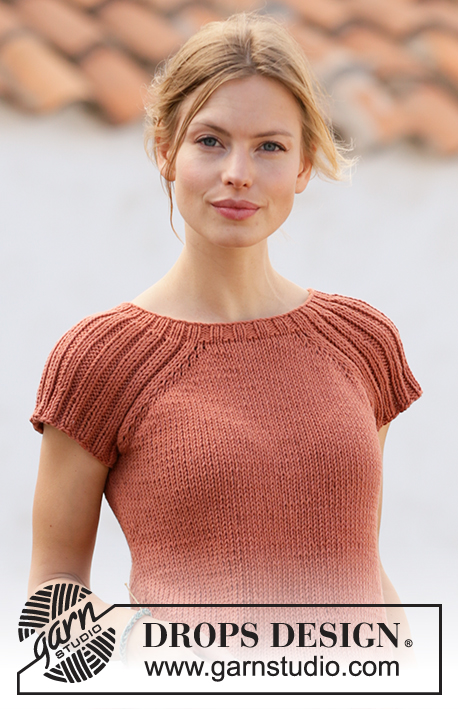 |
Knitted top with raglan in DROPS Paris. Piece is knitted top down with rib. Size: S - XXXL
DROPS 212-15 |
|
|
---------------------------------------------------------- EXPLANATION FOR THE PATTERN: ---------------------------------------------------------- INCREASE TIP-1 (evenly): To calculate how to increase evenly, count the stitches to be increased (e.g. 9 stitches) and divide by stitches of increases to be done (e.g. 2) = 4.5. In this example increase by making 1 yarn over after alternately every 4th and 5th stitch. On next row work yarn overs twisted to avoid holes. INCREASE TIP-2: Increase 1 stitch by making 1 yarn over. On next round purl yarn over twisted to avoid holes. Purl the new stitches. INCREASE TIP-3 (applies to sides of body): Work until 2 stitches remain before marker thread, 1 yarn over, knit 4 (marker thread is in the middle of these stitches), 1 yarn over. On next round knit yarn overs twisted to avoid holes. Then work the new stitches in stocking stitch. DECREASE TIP: Decrease 1 stitch on each side of marker thread as follows: Work until 3 stitches remain before marker thread and knit 2 together, knit 2 (marker thread is between these stitches), slip 1 stitch knitwise, knit 1, pass slipped stitch over stitch worked. RAGLAN: In the beginning increase 2 stitches towards each raglan on front and back piece (= 8 stitches increased on round), and thereafter increase 1 stitch towards each raglan on front and back piece (= 4 stitches increased on round). Increase 2 stitches before marker thread as follows: Work until 2 stitches remain before marker thread: 1 yarn over, knit 1, 1 yarn over, knit 1, marker thread is here. Increase 2 stitches after marker thread as follows: Knit 1, 1 yarn over, knit 1, 1 yarn over. Increase 1 stitch before marker thread as follows: Work until 1 stitch remains before marker thread: 1 yarn over, knit 1, marker thread is here. Increase 1 stitch after marker thread as follows: Knit 1, 1 yarn over. On next round knit yarn overs twisted to avoid holes. Then work the new stitches in stocking stitch. CAST-OFF TIP: To avoid a tight cast-off edge you may use a larger needle. If this also is too tight, make 1 yarn over after approx. every 4th stitch and cast off these as regular stitches. ---------------------------------------------------------- START THE PIECE HERE: ---------------------------------------------------------- TOP - SHORT OVERVIEW OF THE PIECE: Work neck edge and yoke in the round on circular needle from mid back, top down. Now divide yoke for body and sleeves. Work body in the round on circular needle. Work sleeves in the round on double pointed needles/short circular needle, top down. NECK EDGE: Cast on 112-118-126-138-144-144 stitches on circular needle size 3.5 mm with Paris. Knit 1 round. Work next round as follows: (Knit 2/purl 2) over the first 8-8-12-12-12-12 stitches, knit 1, insert a marker thread here (= in transition between back piece and right sleeve), knit 1, (purl 1/knit 2) over the next 33-36-36-42-45-45 stitches, purl 1, knit 1, insert a marker thread here (= in transition between right sleeve and front piece), knit 1, (purl 2/knit 2) over the next 16-16-20-20-20-20 stitches, purl 2, knit 1, insert a marker thread here (= in transition between front piece and left sleeve), knit 1, (purl 1/knit 2) over the next 33-36-36-42-45-45 stitches, purl 1, knit 1, insert a marker thread here (= in transition between left sleeve and back piece), knit 1, (purl 2/knit 2) over the next 8-8-8-8-8-8 stitches, purl 2. Continue in the round like this until rib measures 3 cm. When rib is done, work next round as follows: Knit until first marker thread and increase at the same time 2-3-3-3-3-4 stitches evenly – read INCREASE TIP-1, knit over knit and purl over purl until next marker thread and increase at the same time 1 stitch in every purl section – read INCREASE TIP-2, knit until next marker thread and increase at the same time 4-6-5-5-6-8 stitches evenly, knit over knit and purl over purl until next marker thread and increase at the same time 1 stitch in every purl section, knit the last 11-11-11-11-11-11 stitches and increase at the same time 2-3-2-2-3-4 stitches evenly = 144-156-162-178-188-192 stitches. Work 1 row with knit over knit and purl over purl (work the yarn overs twisted to avoid holes). Switch to circular needle size 5 mm. Insert 1 marker at the beginning of round (= approx. mid back), measure yoke from this marker! YOKE: Knit over knit and purl over purl. On first round start increase for RAGLAN – read explanation above. Only increase on front piece and back piece towards each raglan. Increase 2 stitches every other round 9-9-8-10-12-13 times in total, then increase 1 stitch every other round 2-4-6-6-8-8 times = 224-244-250-282-316-328 stitches. REMEMBER THE KNITTING TENSION! Continue with knit over knit and purl over purl until piece measures 12-13-15-16-18-20 cm from marker. The yoke is finished. Then work in the outermost stitch in each side of front piece and back piece in on sleeves. Work next round as follows: Work the first 30-33-37-41-47-50 stitches, slip the next 50-54-54-62-66-66 stitches on a stitch holder for sleeve and cast on 6-6-10-10-10-14 stitches on needle (= in the side under sleeve), work the next 62-68-71-79-92-98 stitches (= front piece), slip the next 50-54-54-62-66-66 stitches on a stitch holder for sleeve and cast on 6-6-10-10-10-14 stitches on needle (= in the side under sleeve), work the remaining 32-35-34-38-45-48 stitches on needle. Then finish body and sleeves separately. NOW MEASURE PIECE FROM HERE! BODY: = 136-148-162-178-204-224 stitches. Insert 1 marker thread in the in each side, in middle of the new stitches cast-on under the sleeves (= 3-3-5-5-5-7 new stitches on each side of marker thread). Move the marker threads upwards when working; they should be used for increase later in the sides. Work in stocking stitch in the round. When piece measures 4 cm from division, decrease 1 stitch on each side of marker threads - read DECREASE TIP. Decrease like this approx. every 8-7-6-5-4-3 cm 2 times in total = 128-140-154-170-196-216 stitches. When piece measures 20-18-16-14-12-10 cm from division, increase 1 stitch on each side of marker threads - read INCREASE TIP-3. Increase like this approx. every 3-4-4-5-6-6 cm 4-4-4-4-3-3 times in total = 144-156-170-186-208-228 stitches. When piece measures 30 cm from division (3 cm remain until finished measurements - work to desired length), knit 1 round while increasing 28-28-34-38-40-44 stitches = 172-184-204-224-248-272 stitches. Switch to circular needle size 3.5 mm. Work rib (knit 2/purl 2) in the round for 3 cm. Cast off with knit over knit and purl over purl - read CAST-OFF TIP. Top measures total 50-52-54-56-58-60 cm in total from shoulder and down. SLEEVE: Slip the 50-54-54-62-66-66 stitches from stitch holder in one side back on double pointed needles/circular needle size 5 mm, and pick up 1 stitch in each of the 6-6-10-10-10-14 stitches cast on under the sleeve = 56-60-64-72-76-80 stitches. Work rib (knit 2/purl 2) in the round. When sleeve measures 3 cm from division, cast off with knit over knit and purl over purl - remember CAST-OFF TIP. Work the other sleeve the same way. |
|
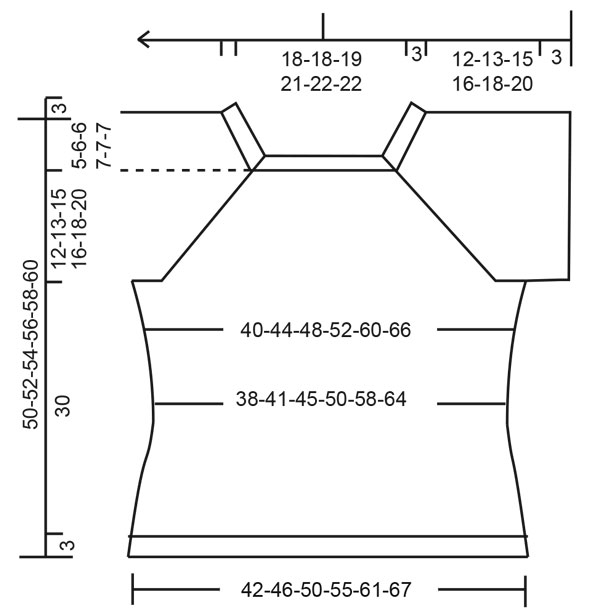 |
|
Have you finished this pattern?Tag your pictures with #dropspattern #canyonclaytop or submit them to the #dropsfan gallery. Do you need help with this pattern?You'll find 24 tutorial videos, a Comments/Questions area and more by visiting the pattern on garnstudio.com. © 1982-2025 DROPS Design A/S. We reserve all rights. This document, including all its sub-sections, has copyrights. Read more about what you can do with our patterns at the bottom of each pattern on our site. |
|







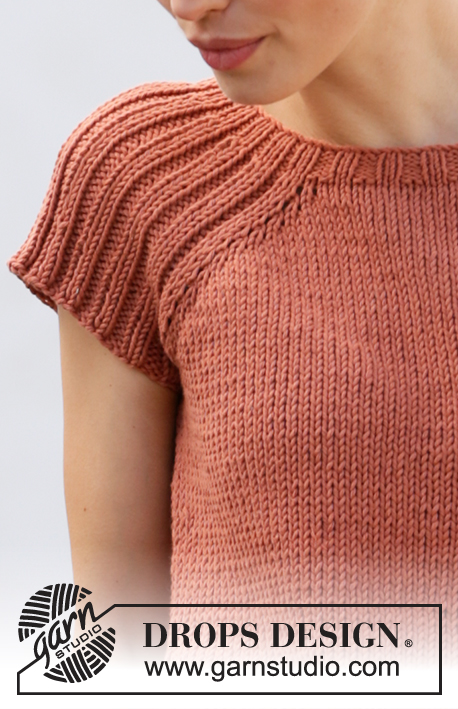

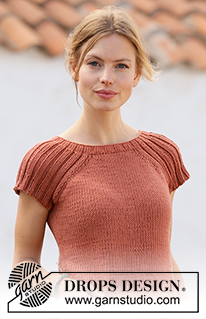
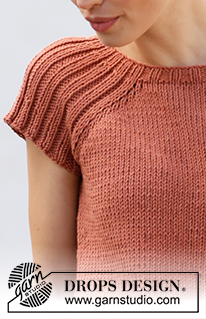







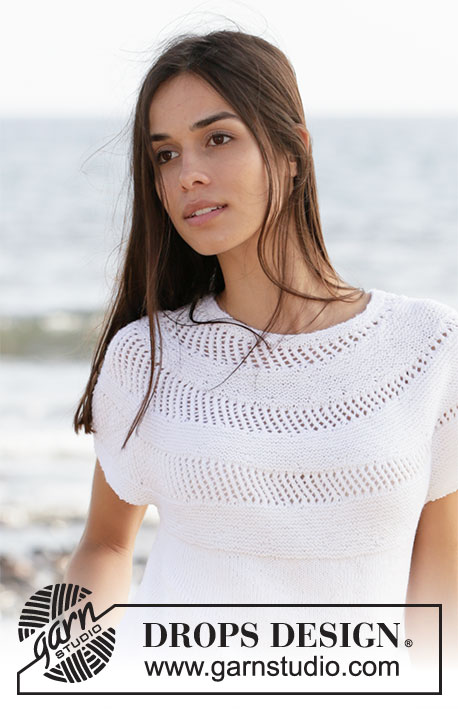
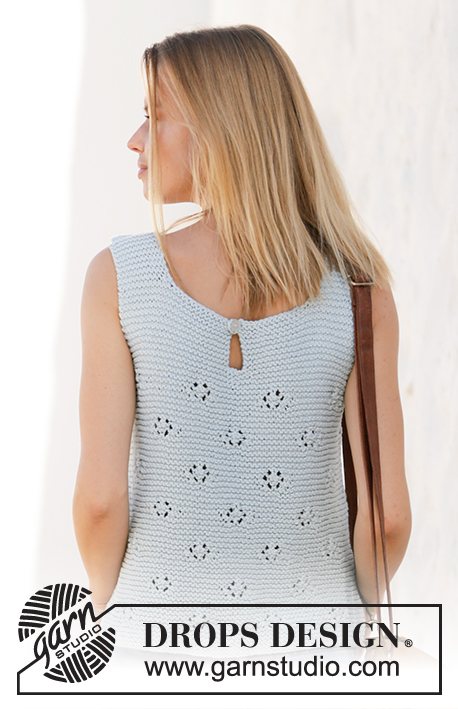
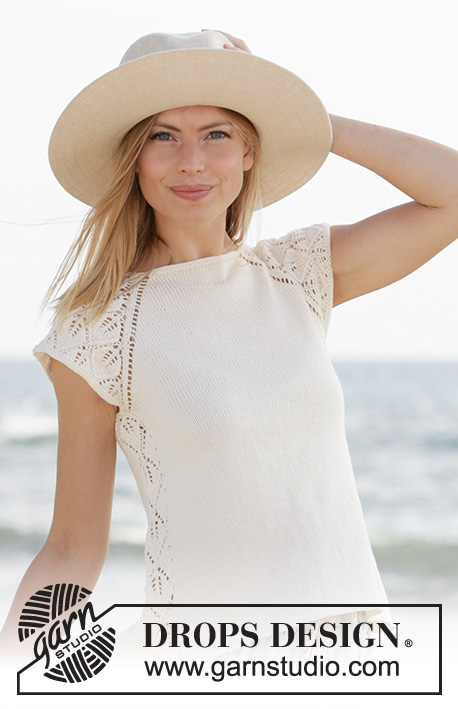




































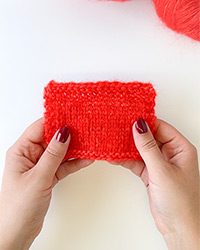
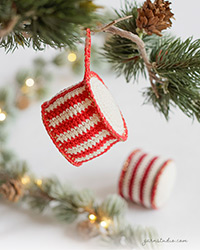




Post a comment to pattern DROPS 212-15
We would love to hear what you have to say about this pattern!
If you want to leave a question, please make sure you select the correct category in the form below, to speed up the answering process. Required fields are marked *.